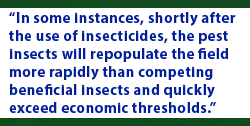
Managing alfalfa insect pests
 By Andrew Heath, Legacy Seeds agronomist
By Andrew Heath, Legacy Seeds agronomistA vigorous, healthy and well-managed alfalfa stand is the basis for profitable forage production. Yield is the most important component of an alfalfa crop’s profitability equation. Protecting alfalfa yield and yield potential from insect pests is critical to a producer’s bottom line. Proper management of insect pests will preserve yield potential for greater feed quality and stand longevity.
Insect pests of alfalfa can affect the plant in several ways:
- The most obvious way is to feed on the leaf material of the plant, like the alfalfa and clover weevil. This reduces the amount of plant harvested and the nutrients within the harvested plant matter.
- The potato leafhopper and aphids cause damage to the plant by sucking the sap from the phloem of the plant. This takes essential nutrients from the plant and prevents the translocation of nutrients and water to the leaves.
- Some alfalfa insect pests can be toxic if ingested by livestock. Cantharidin, a chemical irritant, is found in blister beetles and is deadly to horses.
Managing for these insect pests can be difficult because their lifecycles can vary from year to year. Alfalfa weevils overwinter in the Upper Midwest as eggs. These eggs hatch after approximately 300 growing degree days, and the larvae begin feeding on available foliage by mid- to late-June. The larvae then pupate into adults and leave the field. Whereas potato leafhoppers, which are the most damaging insects to alfalfa crops, migrate to the Upper Midwest from southern regions in late spring. Because of this migration time, and depending on conditions favoring growth, potato leafhoppers can affect alfalfa crops as early as June and as late as early September.
Scouting for alfalfa insect pests is a season-long commitment. One of the most effective ways to scout and evaluate pest populations is with a sweep net. Economic thresholds of pests vary depending on the species, crop stage, cutting schedule and time of the season. One effective management practice is to manipulate the harvest schedule based on the pest population by physically removing the food source from the field. An example of this strategy is if an economic threshold for potato leafhoppers is met three to five days before normal cutting is scheduled. The producer could cut the crop early to preserve yield and quality while eliminating or lessening the pest population.
 Utilizing an insecticide should be done with careful consideration of economic thresholds, pest species and overall insect population because of the widespread control of these products. Populations of pest insects, as well as beneficial insects, will be greatly reduced by using insecticides. In some instances, shortly after the use of insecticides, the pest insects will repopulate the field more rapidly than competing beneficial insects and quickly exceed economic thresholds.
Utilizing an insecticide should be done with careful consideration of economic thresholds, pest species and overall insect population because of the widespread control of these products. Populations of pest insects, as well as beneficial insects, will be greatly reduced by using insecticides. In some instances, shortly after the use of insecticides, the pest insects will repopulate the field more rapidly than competing beneficial insects and quickly exceed economic thresholds.
The cost of many effective insecticides has dropped in recent years. This makes it vital to utilize products in a sustainable and responsible manner to preserve the effectiveness of the insecticides. Some of the most commonly used insecticides in alfalfa production are pyrethroid products, such as Baythroid® (beta-cyfluthrin) and Warrior® (lambda-cyalothrin).
The American Society of Agronomy has published the Alfalfa Management Guide with the help of many professors from land grant universities throughout the Midwest. This is a comprehensive guide to managing alfalfa for increased profitability. For more details on specific alfalfa insect pest species, economic thresholds, and management of these pests, contact your agronomist. Preserving yield and quality of alfalfa harvested for forage by managing for insect pests can lead to more profitability.
| Category: |
Forage Foundations Forage harvesting Forage storage and management |

